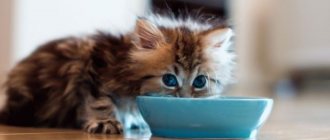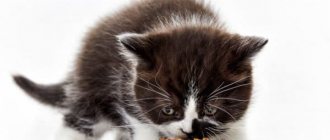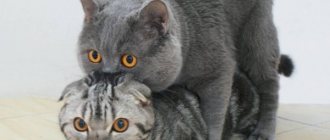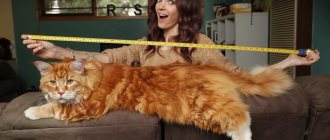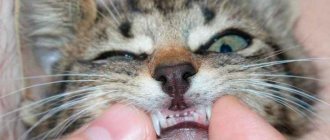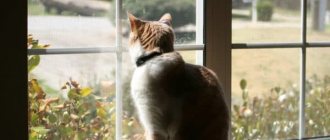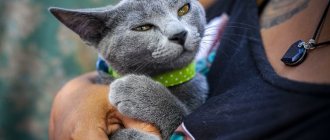Home » Useful Information
A new pet has appeared in the house, but bad luck - it’s too small. Early weaning can occur for many reasons. The situation is serious, and the new owners will have to teach the baby all the necessary skills themselves. One of the problems facing owners is learning to eat independently.
- 1.1 What to do if a kitten finds itself without a mother
1.1.1 Video: how to prepare a mixture for a kitten yourself
- 2 How to introduce the first complementary foods
2.1 Table: sample menu for kittens
- 3.1 Video: how to teach a kitten to eat from a bowl
- 4.1 Video: how to choose a bowl for a kitten
How do newborn kittens feed?
Newborns are fed by the mother, as her colostrum is the most nutritious and safest feeding option. Alternative feeding methods are only permissible if the mother cat does not have breast milk.
Mother's milk
In addition to the nutrients needed for normal growth, breast milk imparts passive immunity. It protects newborns until the first vaccination, that is, up to 2-2.5 months.
This feeding method is the most optimal, since human participation is minimized. It is important for the owner to care only about the quality of the new mother’s nutrition.
Artificial feeding
Before starting artificial feeding, it is better to consult a veterinarian. The stomach of newborns is very small, so it is important to correctly calculate the daily dose.
Babies are fed special formulas that imitate cat's milk. Consumption of goat and cow's milk is not recommended, as these types do not contain the required amount of nutrients and can cause digestive problems.
In the first 2 weeks, furry pets are given warmed milk from a pipette 8 times a day every 2-3 hours. At week 3, they are accustomed to the nipple, reducing the number of feedings to 7 and introducing a five-hour night break.
Measures to ensure the safety of a kitten starting to eat on its own
The baby’s safety while learning to feed himself is a very important aspect:
- Distracting and frightening moments should be eliminated.
- The food itself must be safe, that is, fish, for example, should be thoroughly cleaned of bones; it is strictly forbidden to give river fish: there is a risk of helminth infection.
- The meat should be cooked or pre-frozen for 2-3 days (this will get rid of possible parasites).
- The pieces of meat must be chopped so that the baby does not choke and can chew them well.
- Dry food should be strictly according to age (for kittens, granules are made smaller).
Food manufacturers take into account both the needs and characteristics of kittens, producing special products for them
At what age do kittens begin to eat on their own?
Some animals can allow cubs to breastfeed for up to 6 months, but most often breastfeeding stops at 3 months. Despite this, the first complementary foods are introduced at 1-1.5 months. By this age, the amount of breast milk decreases, and the cat begins to avoid the cubs and more often get out of her house. The most responsible parents show the location of the kitchen, showing their offspring their own bowls.
Due to lack of food, babies begin to look for other sources of nutrition and respond positively to complementary foods. They gradually develop teeth that help them chew harder foods.
Additional Tips
Kittens at a young age eat small amounts of milk, so a regular plastic lid for cans would be a convenient container for them. It is difficult for a kitten to learn to feed itself in a large bowl, since the milk is distributed unevenly, and the animal simply bathes in it.
Milk for feeding should be at room temperature, as too cold or too hot a formula can adversely affect the health of a small pet. You can heat the product using any available methods (microwave, regular heating), but it is important to check the degree of heating itself (no more than 37 degrees).
At first, a pipette, a syringe, or a container for nasal drops are used as a feeding device for a newborn kitten. The container must be thoroughly washed and sterilized before first use.
A kitten that lives with its mother quickly gets used to eating from a bowl after the cat, since she independently ensures that the offspring acquires all the necessary skills. Therefore, it is better to adopt a small pet after two months of age, when it is completely ready for life in a new home and easily adapts.
Rules for introducing complementary foods
Sudden variety is dangerous for a one-month-old baby, so all new products are introduced gradually. Give him no more than one new food every day. This will help track an allergic reaction.
The first complementary foods are given directly from the finger. With the approval of the mustachioed pet, a small portion is mixed into the already familiar food.
At first, all products are pureed. Solid foods are served only after baby teeth appear, that is, at about 2 months. At this age, in addition to slimy porridges, kefir, soft cottage cheese and pureed boiled vegetables, you can add finely chopped meat (lean beef, chicken, turkey, rabbit). Before serving, it must be thoroughly frozen and boiled.
All food should be warm, since too high and low temperatures are harmful to the mucous membranes of the esophagus, stomach and intestines. At first, it is recommended to avoid loud noises in the kitchen. In a calm environment, the baby will be more focused, and therefore will quickly begin to eat on his own.
Why doesn't it work right away?
Many people wonder why it is not immediately possible to teach a kitten to feed from a bowl on its own and should understand that a small kitten that finds itself in a new family takes a longer time to adapt and needs additional care.
In order for the process of accustoming to food to move much faster, you need to diversify your baby’s diet as much as possible. As a result, his taste characteristics will be formed, and he will begin to eagerly eat from the bowl.
During feeding, the presence of the owner is important, since in such conditions the kitten feels comfortable and eats its portion to the end.
What, how much and how often to feed a kitten
Small pets are characterized by rapid growth. On average, they gain 10 g every day. Changes must be constantly monitored to prevent stunting. With proper and balanced nutrition, the likelihood of developmental problems is minimal.
At 1.5 months
At this age, breast milk is still the mainstay of the diet. Additionally, the menu includes:
- rice or semolina porridge, which promotes weight gain;
- boiled chicken or quail yolk;
- vegetable puree from zucchini, cabbage or pumpkin;
- chopped meat;
- low-fat cottage cheese, kefir and yogurt.
Food is given 7 times a day, excluding night feedings. This helps improve your sleep schedule. A single serving should be approximately 17 g, and a daily serving should be 120 g.
At 2 months
When teething, the diet is supplemented with solid food: finely chopped pieces of meat and fish. All of the above products are thoroughly boiled and removed from the bones. The number of feedings is reduced to 6, and the volume of the daily portion is increased to 150 g.
With the advent of solid food, you can refuse minced meat. Only liquid porridges and fermented milk products, which make up 50% of the entire diet, are preserved.
At 3 months
From 3 months to six months there is a rapid growth phase. Muscle mass and skeleton are actively developing. The portion is calculated based on the weight of the animal. For every kg there should be 200 g of food. The baby is fed 5 times a day. After vaccination, it is allowed to introduce boiled offal that has been deep frozen.
The amount of fermented milk products is reduced to ¼ of the diet, and milk is eliminated completely. The animal is given larger pieces of meat and the first raw vegetables (carrots, zucchini). When cooking porridges, reduce the amount of liquid, making them thicker.
Please note that, in addition to natural food, dry food is also acceptable. Choose lines designed specifically for kittens, but no less than premium ones. They are distinguished by their high calorie content and fortified composition. All standards are indicated on the packaging. Before the cloves appear, the granules will have to be soaked in warm water or milk formula.
Drinking regime
It is unnatural for cats to drink a lot of water. They have evolved in such a way that their water needs are almost completely satisfied by the moisture content of their food. So don't worry if your kitten seems to quench its thirst very quickly.
The daily water requirement for a kitten is calculated using a simple formula: body weight multiplied by 0.03. The resulting value includes the water contained in the feed. How much moisture is in the food is indicated on the product label as part of a guaranteed analysis. The moisture content is very different between wet and dry food and the owner should take this into account when feeding the baby.
The kitten must have access to clean water
Give your kitten clean, filtered water. The stale smell will scare the baby away and he will not drink. Also, milk and any other liquids other than water will not work.
Cats like wide bowls because they don't like their whiskers touching anything.
How to teach your baby to eat and drink from a bowl
At a young age, animals often copy the behavior of more experienced relatives. Their main authority is their mother. If a cat shows interest in raising offspring, then she herself teaches him all the basic skills. Otherwise, the owner will have to figure out how to teach the kitten to eat on its own.
For bowl training, use the following tips:
- Separate the cubs from their mother 2 hours before feeding. This will help them work up an appetite.
- Pour warm milk (36 °C) into a tablespoon and offer your pet a try. You can also use a regular finger and dip it in milk.
- If your pet drinks or licks the milk offered, pour a new portion into his bowl. Perform actions right in front of your baby. Having seen and smelled familiar food, he will definitely show interest in the container.
- Don't poke the animal's nose. This can cause unpleasant associations due to the increased sensitivity of the organ. Also, sudden inhalation of liquid can cause aspiration pneumonia.
- If the pet refuses to lap, repeat the second step. Stick your finger in the bowl and offer to try it again. Here you need to be patient. Soon the baby will understand what they want from him and will begin to eat himself.
During the meal, stop attempts to climb into the bowl with all four paws. If you frequently turn the container over, choose a more stable model. Do not use detergents that have a strong odor. Accompany every trip to the kitchen with the word “eat”, reinforcing positive associations. At first, be sure to return the pet to its mother for additional feeding.
A few necessary recommendations
It is difficult for your kitten to feed himself if the dishes are awkward or large, so you should choose dishes that are the right size and that are stable on the floor. This way the baby will feel more comfortable and will eat more willingly.
Don't forget the following simple rules:
- A saucer of water should be placed near the bowl of food.
- You cannot force a kitten to eat.
- Do not mix dry food with regular food. This can only be done when switching from one food to another.
On a note! The kitten will refuse food that is too hot or, on the contrary, cold . Food should be at room temperature.
Possible problems
In addition to observing the norms and frequency of feedings, it is important to avoid prohibited foods. They can lead to disturbances in the gastrointestinal tract, accompanied by complete refusal of food. An animal left without food for a long time may die.
Refusal to eat
If feeding problems occur in newborns, they must be checked by a veterinarian. Pathological reasons for refusing food at such an early age include:
- hypothermia, that is, low body temperature;
- intrauterine infection with leukemia, chlamydia or other dangerous diseases;
- too low weight associated with pathologies of the placenta;
- any intrauterine development disorders;
- internal injuries;
- hemolysis of newborns, accompanied by the destruction of red blood cells by antibodies supplied with colostrum.
If the baby has always had a good appetite, but increasingly refuses to eat after the introduction of complementary foods, then the problem may lie in:
- Stress
. Separating from the mother too early and abruptly switching to new food is harmful for the animal.
- Allergies
. An allergic reaction is accompanied by rashes, hair loss, redness of mucous membranes and other alarming symptoms. To normalize the condition, the allergen is excluded from the diet.
- Gastrointestinal disorder
. If vomiting and diarrhea occur, have your pet checked at a veterinary clinic. In addition to the usual eating disorder, worms or other parasites may be found in the body.
- Incorrectly selected dishes
. The pungent smell of plastic and the presence of dirt are unacceptable for clean representatives of the cat family.
If any alarming symptoms appear, be sure to contact your veterinarian. Kittens are more vulnerable than adult pets, so any delay can cost them their lives.
Prohibited foods
The list of prohibited foods includes everything that appears on the human table: spices, pickles, smoked foods, fried foods, flour and sweets. You should also exclude:
- pork, often contaminated with worms and causing obesity;
- millet and pearl barley porridge, poorly digestible in the stomach;
- grapes (raisins) and mushrooms that can lead to poisoning;
- garlic and onions, which contribute to the development of anemia;
- sorrel, which causes an acute form of gastritis;
- any bones that injure the esophagus and intestines when swallowed;
- a family of legumes that cause increased gas formation.
Milk is removed from the diet by the age of one year. Closely monitor your pet's reaction to this product. If lactose intolerance develops earlier, then it is not necessary to wait a year. This condition is accompanied by severe bloating and diarrhea, so it is difficult to miss.
Fountain for cats
Cats love to drink "live" water that comes from the tap, but most people can't leave the tap open all day, because then the utility bill will be very impressive. The ideal solution for a cat who fundamentally wants to drink only flowing water is to buy a pet fountain. The pet will be able to play with the stream and get plenty of water whenever he wants. But be sure to keep the fountain clean and fill it with fresh water every day.
Using these tips, you can train your cat to drink water, which is so important for its health. But if you have a very wayward pet, try adding catnip, which you can drop directly into the bowl. Or switch to wet food, which does not require your cat to receive additional liquid.
